Evaluation of the Program Subsidizing Prosumer Photovoltaic Sources in Poland
Abstract
1. Introduction
- RQ1: What is the assessment of the effectiveness of the My Electricity program in terms of increasing the production of renewable energy in prosumer sources (the perspective of beneficiaries, legislators, business, local community)?
- RQ2: In what directions should the My Electricity program be modified (amount of support, formal procedures, functionality: energy storage, heating, electromobility)?
- RQ3: How is PV technology perceived in terms of the safety of its users and its impact on the environment?
2. Literature Review
2.1. The My Electricity Program as a Subject of Empirical Research
2.2. Technical Limitations of PV System Development in Poland
2.3. Determinants of Decisions on Investments in PV Micro-Installations
3. Materials and Methods
3.1. Choosing a Research Method
3.2. Research Sample
3.3. Collecting Data
3.4. Data Analysis
4. Results
4.1. Enthusiasm about Prosumer PV Installations
4.2. Skepticism towards PV Micro-Installations
4.3. Balancing Enthusiasm and Skepticism—Expert Opinions
5. Discussion of Findings
5.1. Implication for Research and Practice
5.2. Limitation
Supplementary Materials
Author Contributions
Funding
Institutional Review Board Statement
Informed Consent Statement
Data Availability Statement
Conflicts of Interest
References
- GOV. Available online: https://www.gov.pl/web/klimat/polityka-energetyczna-polski (accessed on 27 August 2021).
- Turek, M. Walka Ze Smogiem. Koncepcja Opracowania Ogólnokrajowego Programu Likwidacji Niskiej Emisji. Przem. Chem. 2017, 1, 100–103. [Google Scholar] [CrossRef]
- Turek, M.; Antos, M. Główny Instytut Górnictwa. In Niska Emisja—Węgiel Tak, Smog Nie: Praca Zbiorowa; Główny Instytut Górnictwa: Katowice, Poland, 2018; ISBN 978-83-65503-15-2. [Google Scholar]
- Gruchelski, M.; Garbicz, M. Oficyna Wydawnicza Aspra-JR. In Sektor Prywatny a Sektor Publiczny: Ujęcie Interdyscyplinarne; Oficyna Wydawnicza ASPRA-JR: Warszawa, Poland, 2020; ISBN 978-83-8209-018-5. [Google Scholar]
- Gaj, K.; Miller, U.; Sówka, I. Progressing Climate Changes and Deteriorating Air Quality as One of the Biggest Challenges of Sustainable Development of the Present Decade in Poland. Sustainability 2020, 12, 6367. [Google Scholar] [CrossRef]
- Jacobson, M.Z.; Delucchi, M.A.; Bauer, Z.A.F.; Goodman, S.C.; Chapman, W.E.; Cameron, M.A.; Bozonnat, C.; Chobadi, L.; Clonts, H.A.; Enevoldsen, P.; et al. 100% Clean and Renewable Wind, Water, and Sunlight All-Sector Energy Roadmaps for 139 Countries of the World. Joule 2017, 1, 108–121. [Google Scholar] [CrossRef]
- Sampedro, J.; Arto, I.; González-Eguino, M. Implications of Switching Fossil Fuel Subsidies to Solar: A Case Study for the European Union. Sustainability 2017, 10, 50. [Google Scholar] [CrossRef]
- Siudek, A.; Klepacka, A.M.; Florkowski, W.J.; Gradziuk, P. Renewable Energy Utilization in Rural Residential Housing: Economic and Environmental Facets. Energies 2020, 13, 6637. [Google Scholar] [CrossRef]
- Fit for 55. Available online: https://www.consilium.europa.eu/en/policies/eu-plan-for-a-green-transition/ (accessed on 8 November 2021).
- Tokarski, S.; Magdziarczyk, M.; Smoliński, A. Risk Management Scenarios for Investment Program Delays in the Polish Power Industry. Energies 2021, 14, 5210. [Google Scholar] [CrossRef]
- Olczak, P.; Matuszewska, D.; Kryzia, D. “Mój Prąd” as an Example of the Photovoltaic One off Grant Program in Poland. Polityka Energ. Energy Policy J. 2020, 23, 123–138. [Google Scholar] [CrossRef]
- Olczak, P.; Olek, M.; Matuszewska, D.; Dyczko, A.; Mania, T. Monofacial and Bifacial Micro PV Installation as Element of Energy Transition—The Case of Poland. Energies 2021, 14, 499. [Google Scholar] [CrossRef]
- NFOŚiGW Program. “Mój Prąd"—Założenia Szczegółowe. Available online: https://www.gov.pl/web/nfosigw/program-moj-prad--zalozenia-szczegolowe (accessed on 8 November 2021).
- NFOŚiGW: Ponad 110 Tysięcy Wniosków o Dotację Na Fotowoltaikę w Trzeciej Edycji Programu “Mój Prąd”; Alokacja Drugiej Edycji Programu Na Wyczerpaniu. Available online: https://www.gov.pl/web/nfosigw/nfosigw-ponad-110-tysiecy-wnioskow-o-dotacje-na-fotowoltaike-w-trzeciej-edycji-programu-moj-prad-alokacja-drugiej-edycji-programu-na-wyczerpaniu (accessed on 8 November 2021).
- Budin, L.; Grdenić, G.; Delimar, M. A Quadratically Constrained Optimization Problem for Determining the Optimal Nominal Power of a PV System in Net-Metering Model: A Case Study for Croatia. Energies 2021, 14, 1746. [Google Scholar] [CrossRef]
- Zarębski, P.; Krupin, V.; Zwęglińska-Gałecka, D. Renewable Energy Generation Gaps in Poland: The Role of Regional Innovation Systems and Knowledge Transfer. Energies 2021, 14, 2935. [Google Scholar] [CrossRef]
- Szultka, A.; Szultka, S.; Czapp, S.; Zajczyk, R. Voltage Variations and Their Reduction in a Rural Low-Voltage Network with PV Sources of Energy. Electronics 2021, 10, 1620. [Google Scholar] [CrossRef]
- Jasiński, J.; Kozakiewicz, M.; Sołtysik, M. Determinants of Energy Cooperatives’ Development in Rural Areas—Evidence from Poland. Energies 2021, 14, 319. [Google Scholar] [CrossRef]
- Ruf, H. Limitations for the Feed-in Power of Residential Photovoltaic Systems in Germany—An Overview of the Regulatory Framework. Sol. Energy 2018, 159, 588–600. [Google Scholar] [CrossRef]
- Parzonko, A.J.; Balińska, A.; Sieczko, A. Pro-Environmental Behaviors of Generation Z in the Context of the Concept of Homo Socio-Oeconomicus. Energies 2021, 14, 1597. [Google Scholar] [CrossRef]
- Faiers, A.; Neame, C. Consumer Attitudes towards Domestic Solar Power Systems. Energy Policy 2006, 34, 1797–1806. [Google Scholar] [CrossRef]
- Briguglio, M.; Formosa, G. When Households Go Solar: Determinants of Uptake of a Photovoltaic Scheme and Policy Insights. Energy Policy 2017, 108, 154–162. [Google Scholar] [CrossRef]
- Müller, S.; Rode, J. The Adoption of Photovoltaic Systems in Wiesbaden, Germany. Econ. Innov. New Technol. 2013, 22, 519–535. [Google Scholar] [CrossRef]
- Zhang, Y.; Song, J.; Hamori, S. Impact of Subsidy Policies on Diffusion of Photovoltaic Power Generation. Energy Policy 2011, 39, 1958–1964. [Google Scholar] [CrossRef]
- Graziano, M.; Gillingham, K. Spatial Patterns of Solar Photovoltaic System Adoption: The Influence of Neighbors and the Built Environment. J. Econ. Geogr. 2015, 15, 815–839. [Google Scholar] [CrossRef]
- Müller, J.; Trutnevyte, E. Spatial Projections of Solar PV Installations at Subnational Level: Accuracy Testing of Regression Models. Appl. Energy 2020, 265, 114747. [Google Scholar] [CrossRef]
- Best, R.; Burke, P.J.; Nishitateno, S. Evaluating the Effectiveness of Australia’s Small-Scale Renewable Energy Scheme for Rooftop Solar. Energy Econ. 2019, 84, 104475. [Google Scholar] [CrossRef]
- Kowalska-Pyzalska, A. An Empirical Analysis of Green Electricity Adoption Among Residential Consumers in Poland. Sustainability 2018, 10, 2281. [Google Scholar] [CrossRef]
- Lekavičius, V.; Bobinaitė, V.; Galinis, A.; Pažėraitė, A. Distributional Impacts of Investment Subsidies for Residential Energy Technologies. Renew. Sustain. Energy Rev. 2020, 130, 109961. [Google Scholar] [CrossRef]
- Nicolini, M.; Tavoni, M. Are Renewable Energy Subsidies Effective? Evidence from Europe. Renew. Sustain. Energy Rev. 2017, 74, 412–423. [Google Scholar] [CrossRef]
- Lewandowska, A.; Chodkowska-Miszczuk, J.; Rogatka, K.; Starczewski, T. Smart Energy in a Smart City: Utopia or Reality? Evidence from Poland. Energies 2020, 13, 5795. [Google Scholar] [CrossRef]
- Ropuszyńska-Surma, E.; Węglarz, M. Profiling End User of Renewable Energy Sources among Residential Consumers in Poland. Sustainability 2018, 10, 4452. [Google Scholar] [CrossRef]
- Yang, X.; He, L.; Xia, Y.; Chen, Y. Effect of Government Subsidies on Renewable Energy Investments: The Threshold Effect. Energy Policy 2019, 132, 156–166. [Google Scholar] [CrossRef]
- De Doile, G.N.D.; Rotella Junior, P.; Carneiro, P.F.G.; Peruchi, R.S.; Rocha, L.C.S.; Janda, K.; Aquila, G. Economic Feasibility of Photovoltaic Micro-Installations Connected to the Brazilian Distribution Grid in Light of Proposed Changes to Regulations. Energies 2021, 14, 1529. [Google Scholar] [CrossRef]
- Doris, E.; Krasko, V.A. Strategic Sequencing for State Distributed PV Policies: A Quantitative Analysis of Policy Impacts and Interactions; National Renewable Energy Laboratory: Washington, DC, USA, 2012. [CrossRef][Green Version]
- Ryan, A.J.; Donou-Adonsou, F.; Calkins, L.N. Subsidizing the Sun: The Impact of State Policies on Electricity Generated from Solar Photovoltaic. Econ. Anal. Policy 2019, 63, 1–10. [Google Scholar] [CrossRef]
- Bollinger, B.; Gillingham, K. Peer Effects in the Diffusion of Solar Photovoltaic Panels. Mark. Sci. 2012, 31, 900–912. [Google Scholar] [CrossRef]
- Davidson, C.; Drury, E.; Lopez, A.; Elmore, R.; Margolis, R. Modeling Photovoltaic Diffusion: An Analysis of Geospatial Datasets. Environ. Res. Lett. 2014, 9, 074009. [Google Scholar] [CrossRef]
- Balta-Ozkan, N.; Yildirim, J.; Connor, P.M. Regional Distribution of Photovoltaic Deployment in the UK and Its Determinants: A Spatial Econometric Approach. Energy Econ. 2015, 51, 417–429. [Google Scholar] [CrossRef]
- Schaffer, A.J.; Brun, S. Beyond the Sun—Socioeconomic Drivers of the Adoption of Small-Scale Photovoltaic Installations in Germany. Energy Res. Soc. Sci. 2015, 10, 220–227. [Google Scholar] [CrossRef]
- Sommerfeld, J.; Buys, L.; Mengersen, K.; Vine, D. Influence of Demographic Variables on Uptake of Domestic Solar Photovoltaic Technology. Renew. Sustain. Energy Rev. 2017, 67, 315–323. [Google Scholar] [CrossRef]
- Richter, L.-L. Social Effects in the Diffusion of Solar Photovoltaic Technology in the UK; Apollo-University of Cambridge Repository: Cambridge, UK, 2013. [Google Scholar] [CrossRef]
- Rode, J.; Weber, A. Does Localized Imitation Drive Technology Adoption? A Case Study on Rooftop Photovoltaic Systems in Germany. J. Environ. Econ. Manag. 2016, 78, 38–48. [Google Scholar] [CrossRef]
- Balta-Ozkan, N.; Yildirim, J.; Connor, P.M.; Truckell, I.; Hart, P. Energy Transition at Local Level: Analyzing the Role of Peer Effects and Socio-Economic Factors on UK Solar Photovoltaic Deployment. Energy Policy 2021, 148, 112004. [Google Scholar] [CrossRef]
- Alipour, M.; Salim, H.; Stewart, R.A.; Sahin, O. Predictors, Taxonomy of Predictors, and Correlations of Predictors with the Decision Behaviour of Residential Solar Photovoltaics Adoption: A Review. Renew. Sustain. Energy Rev. 2020, 123, 109749. [Google Scholar] [CrossRef]
- Venkatesh, V.; Morris, M.G.; Davis, G.B.; Davis, F.D. Davis User Acceptance of Information Technology: Toward a Unified View. MIS Q. 2003, 27, 425. [Google Scholar] [CrossRef]
- Styczyński, J. Zrobieni Na Zielono, Czyli Wszystkie Grzechy Sprzedawców Fotowoltaiki. Available online: https://www.gazetaprawna.pl/magazyn-na-weekend/artykuly/8221715,glowne-grzechy-fotowoltaiki.html (accessed on 8 November 2021).
- Kołtowski, K. Pożary Instalacji Fotowoltaicznych. Eksperci Radzą Jak Ich Uniknąć. Available online: https://gadzetomania.pl/62633,pozary-instalacji-fotowoltaicznych-eksperci-radza-jak-ich-uniknac (accessed on 27 August 2021).
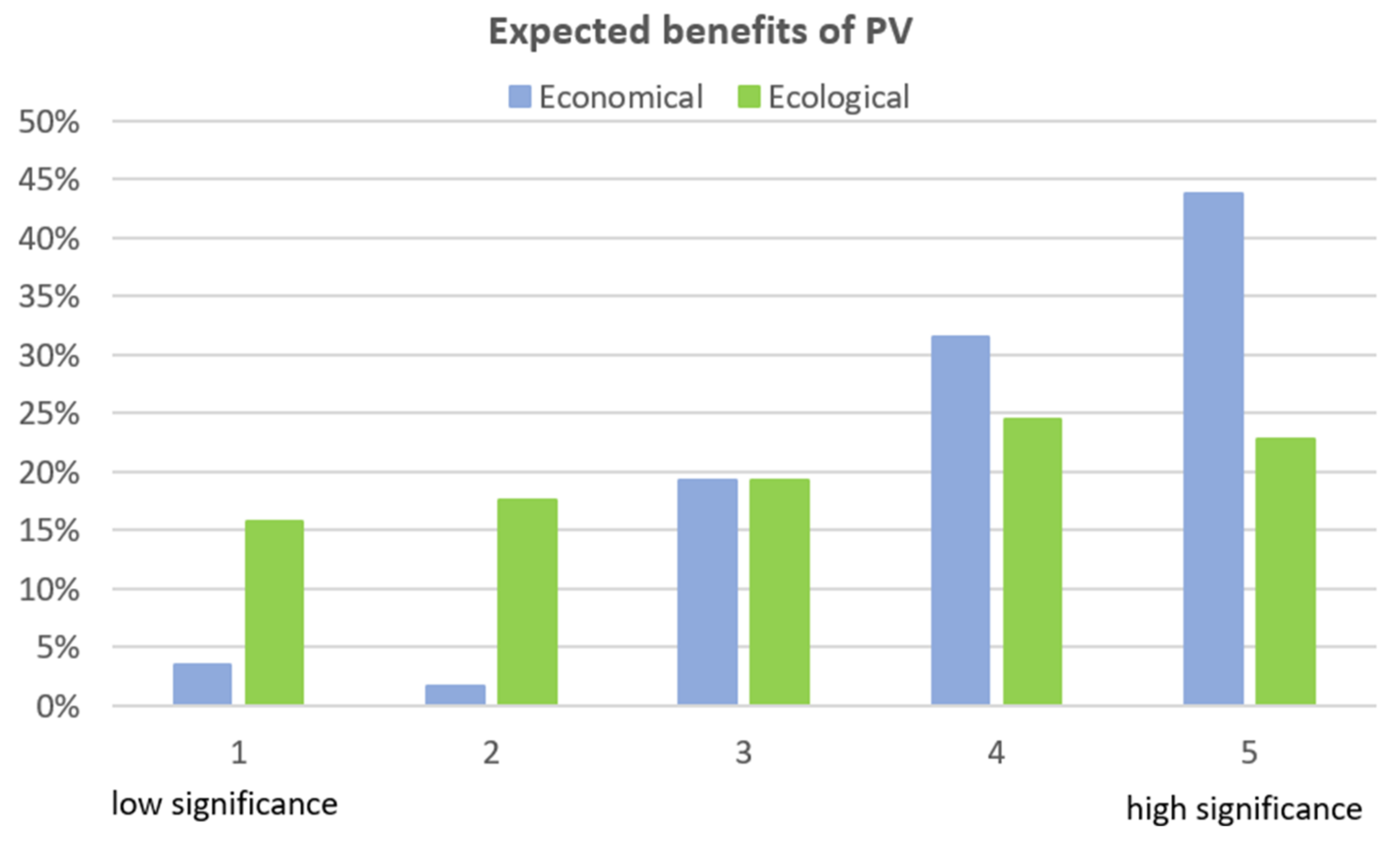

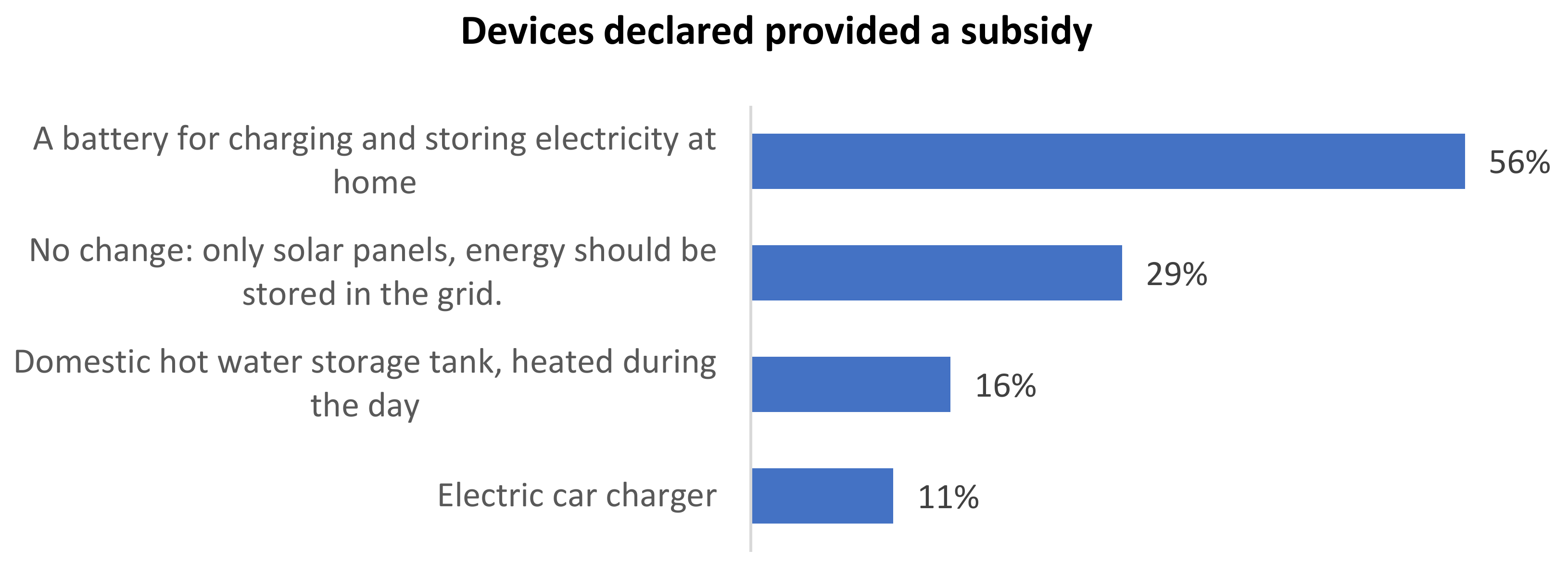
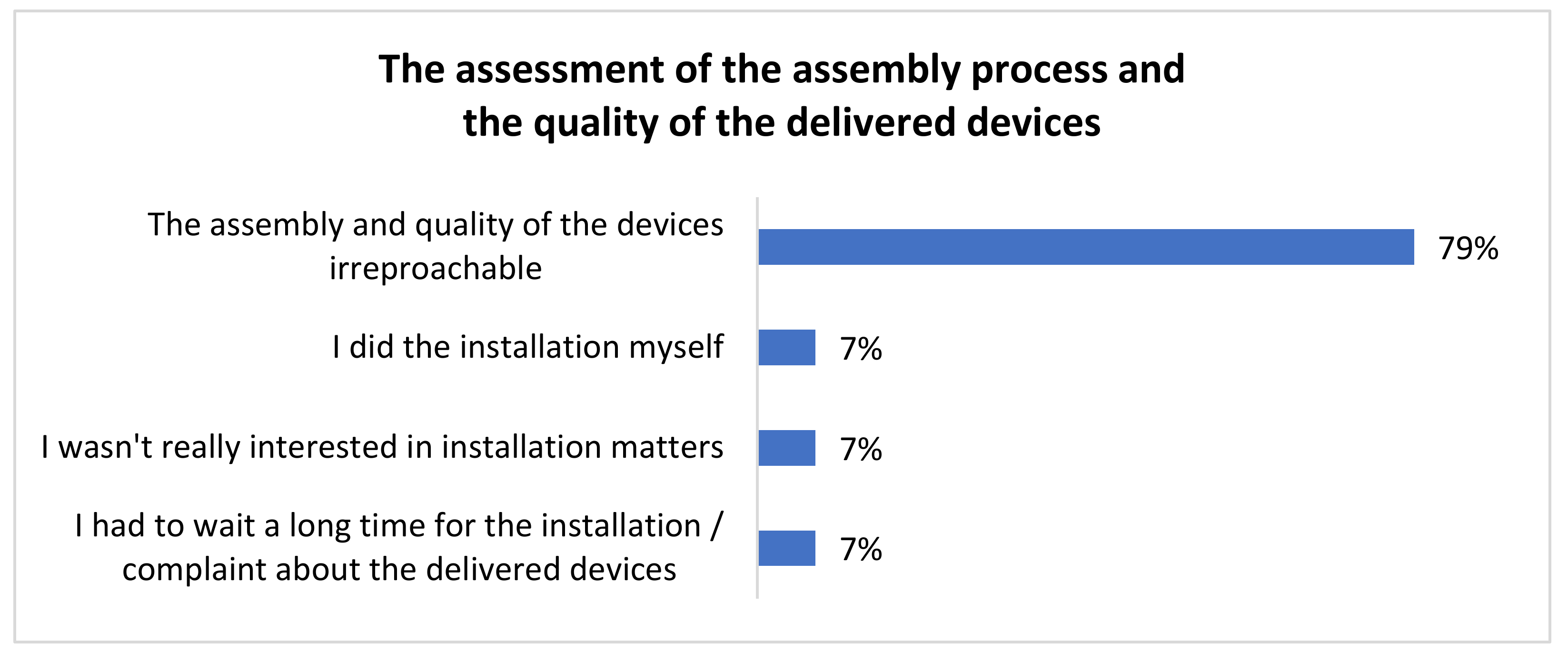

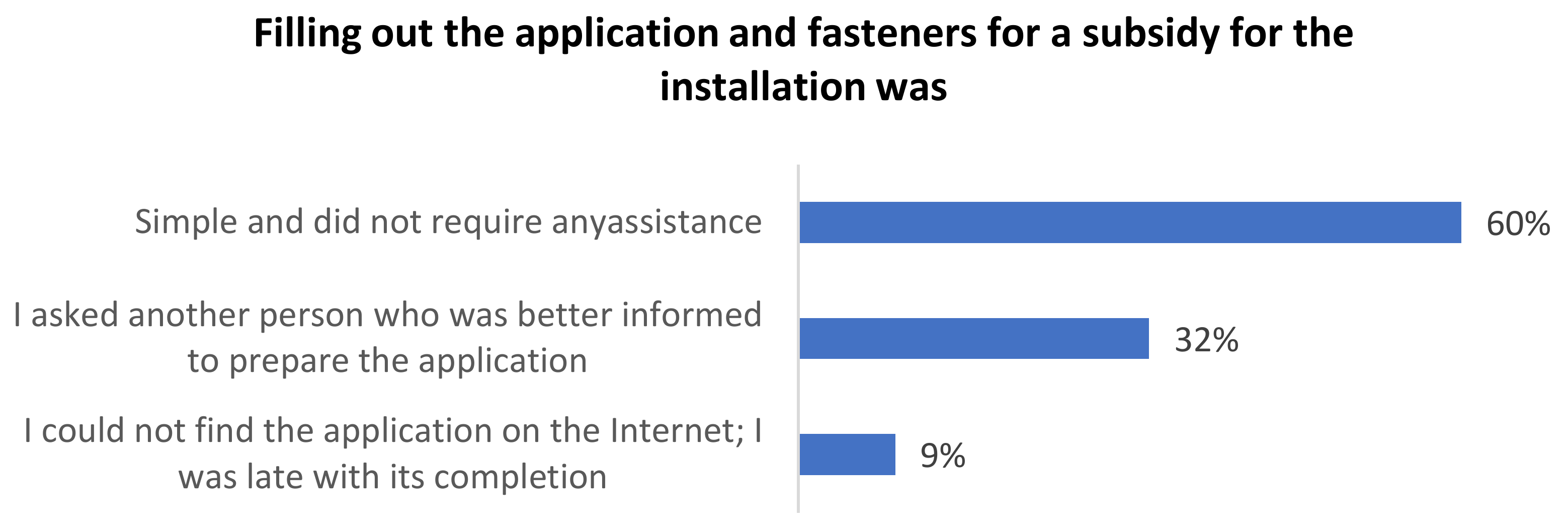
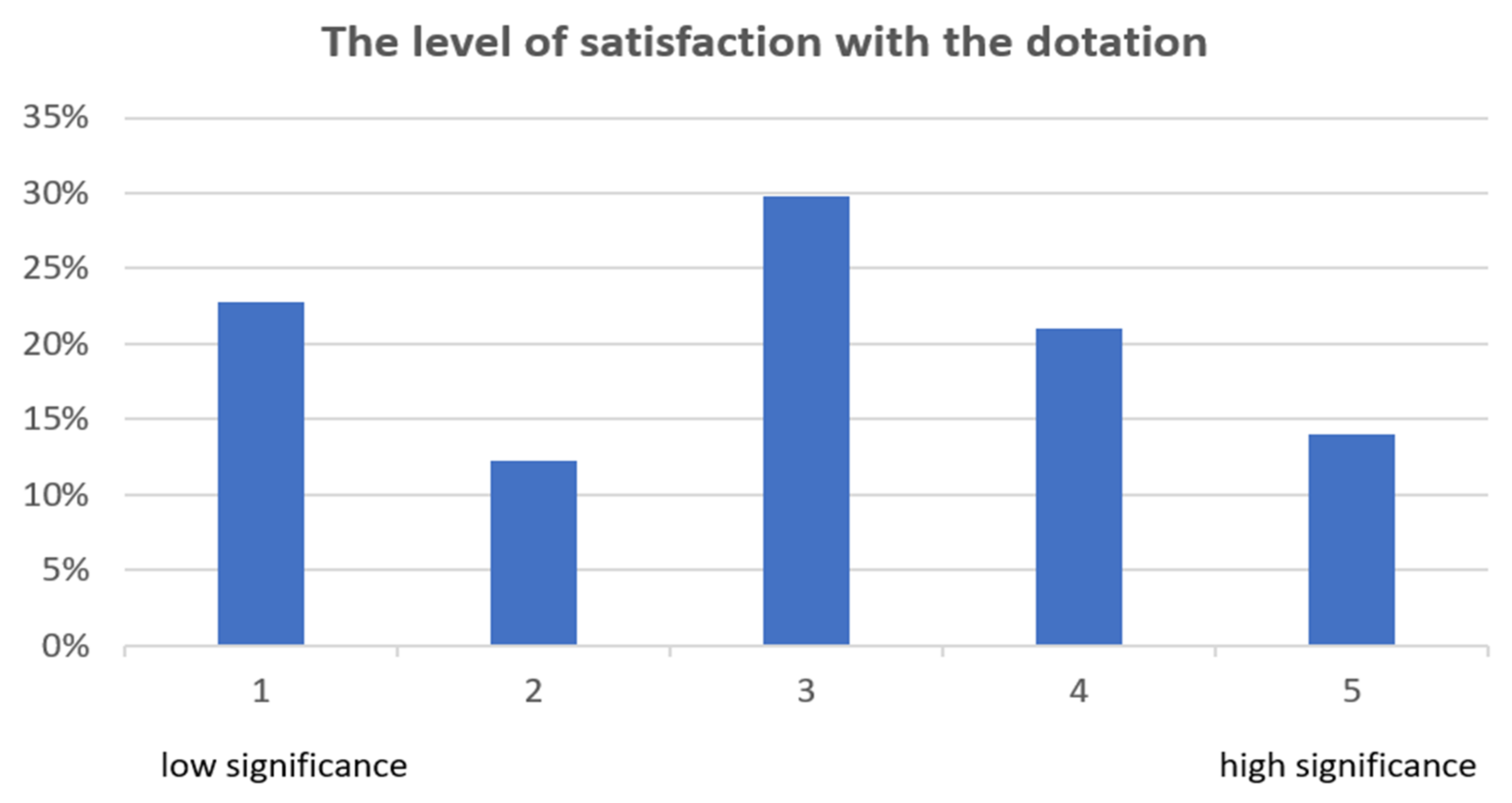

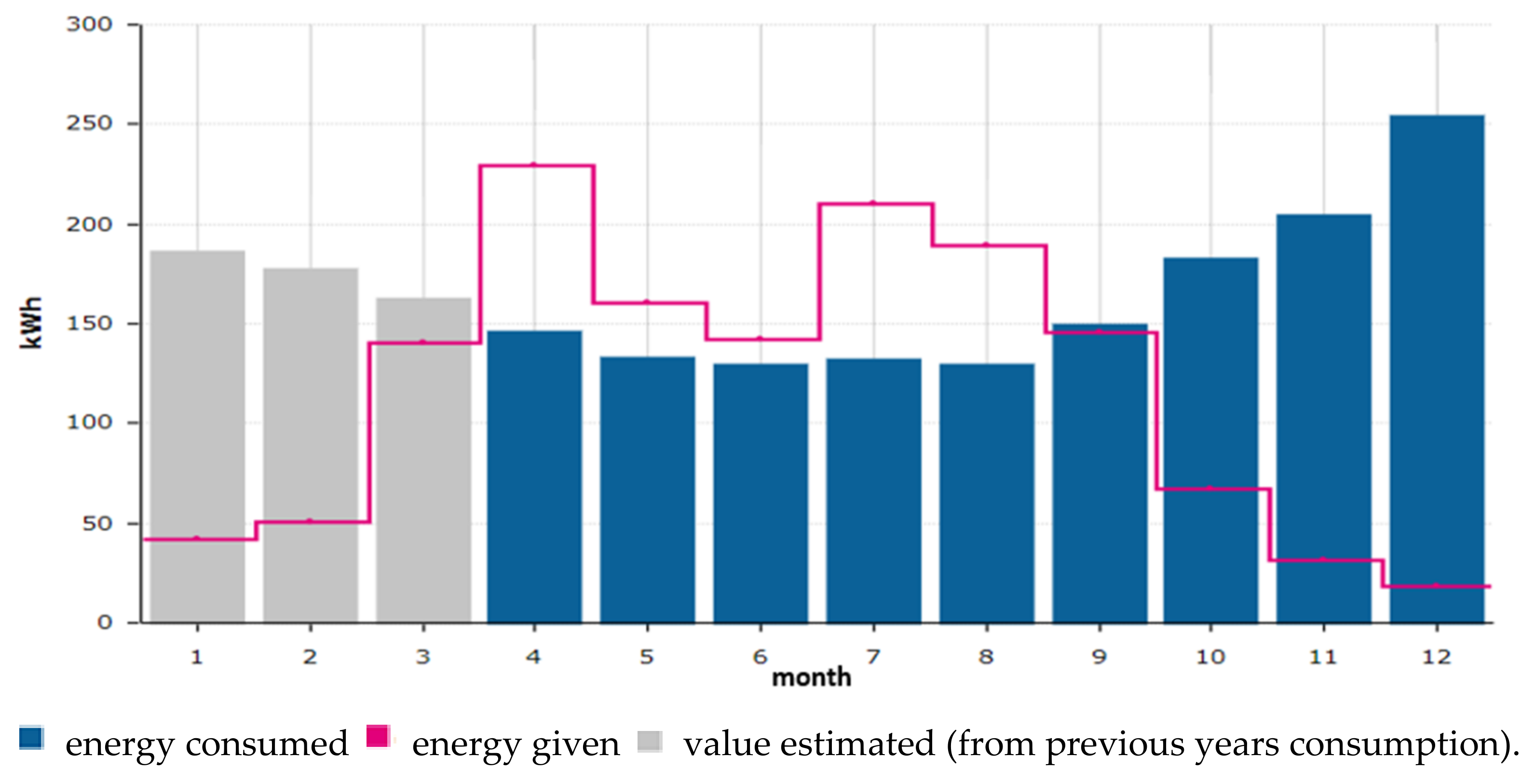
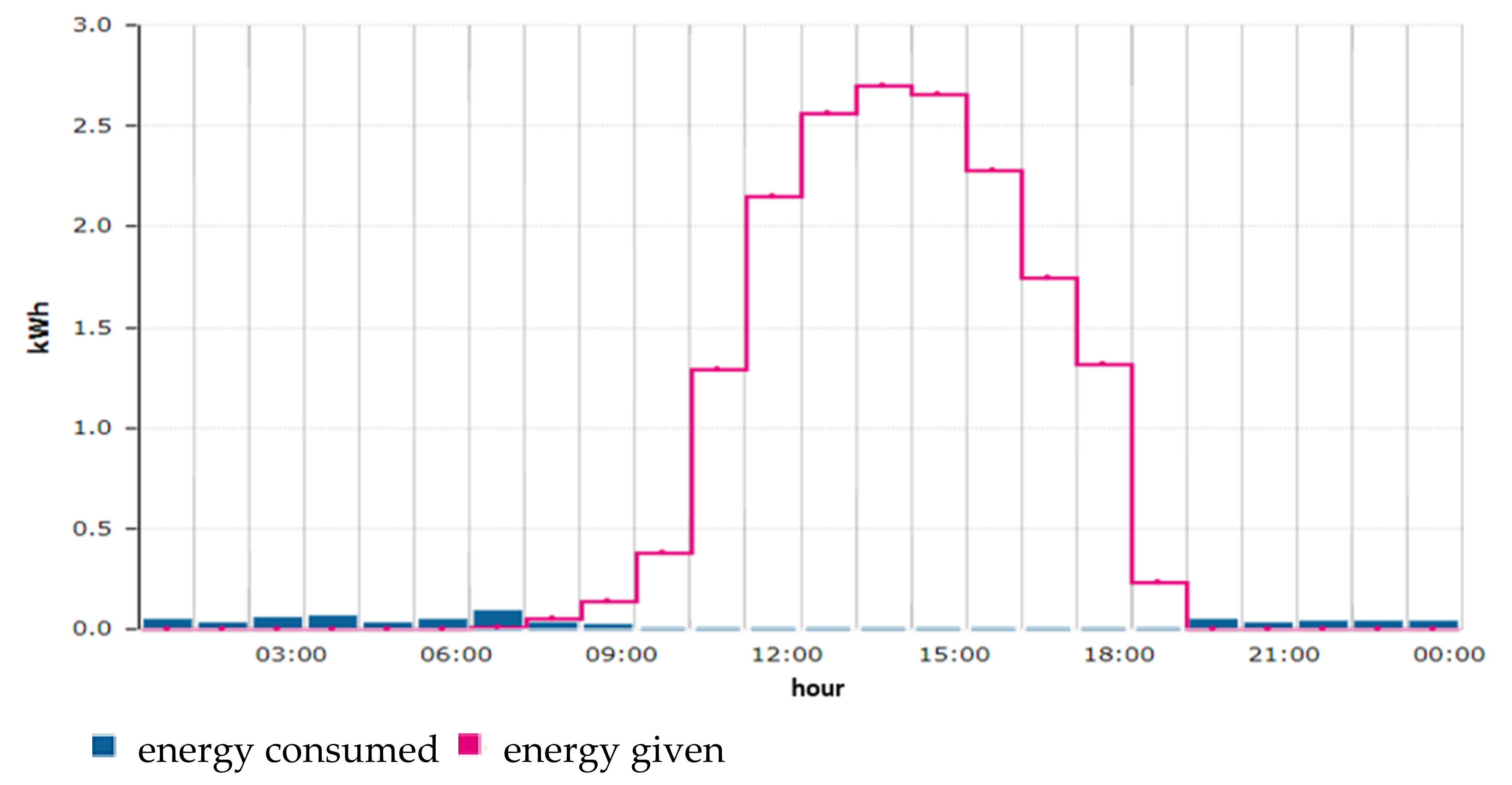
| Type of Research | Type of Respondents | Type of Interaction | |
|---|---|---|---|
| Qualitative research | Enthusiasts | 12 | Interviews conducted via instant messaging |
| Skeptics | 7 | ||
| Experts | 5 | ||
| Quantitative research | Enthusiasts | 57 | Online survey |
| Benefits | Group of Factors |
|---|---|
| Lower electricity bills | Economic benefits (Primary investment motivators) |
| The grant from the My Electricity program | |
| Tax relief | |
| Source of green energy | Environmental benefits (Secondary investment motivators) |
| Reduction of CO2 emissions | |
| Following ecological trends related to environmental protection | |
| Ecological energy production | |
| Possibility of connecting other electric equipment in the future (e.g., car chargers, heat pumps, saunas) | Energy security |
| Possibility to produce own electricity | |
| Transformation of the Polish energy system | |
| Ease and speed of installation | Other benefits |
| Maintenance-free operation of the installation | |
| Greater installation appearance compared to that of wind installations |
| Effort | Amount |
|---|---|
| Financial cost | Average for small installations, high for large installations |
| Installation | Low effort |
| Learning to operate | Low effort |
| Disposal | An unknown amount of effort |
| Social Influence | Group of Factors |
|---|---|
| Recommended by other PV system users | Opinions of friends (Economic reasons) |
| Observation of behavior in the neighborhood and conversation (neighbors) | |
| Observation of behavior in other countries | Ecological behavior (Environmental awareness) |
| The trend towards zero-emission energy production | |
| Phones with installation suggestions | Advertising of installation companies (marketing) |
| Lower installation prices | |
| Increasing electricity prices | Other (Own analysis) |
| The grant from the My Electricity program/tax relief |
| Favorable Conditions | Rating |
|---|---|
| Completing the grant application | Not difficult or completed by the company |
| Ease of finding a contractor | High (recommended by a friend) |
| Contractor assessment | Good/very good |
| Satisfaction with the way the grant application is handled | On average 4 month waiting time (if longer: impatient) |
| Operation | Assessment |
|---|---|
| My Electricity program | Most of the respondents are satisfied with the program (average grade: 4.18); only one respondent expressed a negative opinion (due to the long waiting time for the subsidy) |
| Functioning of PV installations | Most of the respondents are satisfied with the PV installation (average grade: 4.73) |
| PV system technology | 7 respondents assessed the technology very positively, 2 respondents underlined the high cost of installation, 2 respondents forecasted the development of other energy technologies, 1 respondent did not see the development of PV technology without simultaneous investments in energy storage. |
| Concerns | Group of Factors |
|---|---|
| Too high investment cost and too little grant amounts | Finances |
| Uncertainty of the return on investment and the risk of additional costs | |
| The prospect of ending the net metering system and switching to a purchase and sale system | |
| No preparation of the Polish power grid | Technology |
| Pushing outdated technological ideas out | |
| Risk of careless installation | |
| Risk of problems with servicing the installation in the future | |
| Aggressive marketing of traders of companies installing home PV systems | Social relations |
| Fire hazards | Energy |
| The problem with disposal after the PV installation becomes unusable | Ecology |
Publisher’s Note: MDPI stays neutral with regard to jurisdictional claims in published maps and institutional affiliations. |
© 2022 by the authors. Licensee MDPI, Basel, Switzerland. This article is an open access article distributed under the terms and conditions of the Creative Commons Attribution (CC BY) license (https://creativecommons.org/licenses/by/4.0/).
Share and Cite
Zdonek, I.; Tokarski, S.; Mularczyk, A.; Turek, M. Evaluation of the Program Subsidizing Prosumer Photovoltaic Sources in Poland. Energies 2022, 15, 846. https://doi.org/10.3390/en15030846
Zdonek I, Tokarski S, Mularczyk A, Turek M. Evaluation of the Program Subsidizing Prosumer Photovoltaic Sources in Poland. Energies. 2022; 15(3):846. https://doi.org/10.3390/en15030846
Chicago/Turabian StyleZdonek, Iwona, Stanisław Tokarski, Anna Mularczyk, and Marian Turek. 2022. "Evaluation of the Program Subsidizing Prosumer Photovoltaic Sources in Poland" Energies 15, no. 3: 846. https://doi.org/10.3390/en15030846
APA StyleZdonek, I., Tokarski, S., Mularczyk, A., & Turek, M. (2022). Evaluation of the Program Subsidizing Prosumer Photovoltaic Sources in Poland. Energies, 15(3), 846. https://doi.org/10.3390/en15030846







